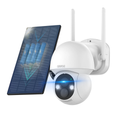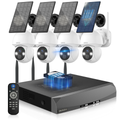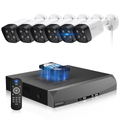Exploring OHWOAI's Wireless Surveillance Systems for Enhanced Security
OHWOAI Surveillance takes pride in offering state-of-the-art wireless surveillance systems, which utilize advanced wireless technology to establish seamless connections between monitored sites and our surveillance center. These systems enable real-time transmission of live video feeds from different locations to our wireless monitoring center, providing users with instant access to crucial visual information.
Wireless Surveillance System Capabilities: OHWOAI's wireless surveillance systems combine the power of surveillance and wireless transmission technologies. They allow for real-time transmission of live video feeds from various locations through wireless communication channels to the wireless monitoring center. Additionally, these systems automatically generate a video database for convenient future retrieval.
In a wireless surveillance system, the wireless monitoring center requires real-time access to high-quality video feeds from the monitored sites. To achieve this, live footage is captured using cameras strategically placed at the surveillance points. These cameras are connected to video wireless transmission devices, which use radio waves to send data signals to the monitoring center. Within the network, authorized users equipped with client software or using web browsers with different permission levels can control and observe real-time video scenes captured by individual cameras. They can remotely adjust camera settings such as focus, aperture, depth of field, and even control the pan-tilt-zoom (PTZ) functionality for precise monitoring.
Components of a Wireless Surveillance System: OHWOAI's wireless surveillance system comprises the following key components:
(1) Monitoring Center: Responsible for managing and commanding the entire surveillance system, including user and device access management, video access and control services, and video recording and processing services.
(2) Transmission System: Wireless networks play a significant role, utilizing technologies such as WiFi, 5G, IP, and other broadband wireless systems. These advancements enable wireless surveillance to thrive in both industry and residential settings.
(3) Information Acquisition System: This includes front-end devices such as video servers, cameras, and PTZs. PTZs allow for 360° rotation, vertical adjustment of 90°, and control over zoom functionality. Video encoders/decoders convert analog video signals from the cameras into digital signals while compressing and encoding them. These encoded and compressed data are then transmitted through the network to the monitoring management center.
(4) Client Interface: Users can access live video feeds and control remote devices through web browsers or dedicated client software. After user authentication, they can view videos, control camera angles, zoom in or out, and receive alarm notifications.
Advantages of Wireless Surveillance Systems: OHWOAI's wireless surveillance systems offer numerous benefits, including:
Cost-Effectiveness: Wireless systems require a one-time investment, making them ideal for outdoor applications or locations with long distances. Wired installations in challenging environments like mountains or vast open areas can be inconvenient and time-consuming. Wireless surveillance eliminates the need for extensive cabling, resulting in shorter installation periods, easy maintenance, and strong scalability, thereby rapidly recovering costs.
Flexibility and Scalability: Wireless surveillance systems offer easy network expansion and plug-and-play functionality. Administrators can swiftly add new wireless monitoring points to the existing network without the need for additional network infrastructure or equipment, enabling remote wireless monitoring to be effortlessly implemented.
Low Maintenance Costs: Wireless surveillance systems are maintained by network providers, offering plug-and-play, maintenance-free systems on the user end.
Powerful Functionality and Versatile Utilization: These systems provide all-digital video recording, making it convenient to store and retrieve footage. Users can play, locate, fast-forward, and slow-motion recorded videos based on their requirements. Multiple screen displays and two-way communication allow monitoring centers to switch between single and multi-screen displays effortlessly and communicate with the control room at the monitoring point.
Remote Monitoring and Alarm Capabilities: Wireless surveillance systems can be integrated with sensors for remote monitoring, control, and alarm functionalities. They automatically transmit real-time images and relevant information from remote monitoring points to the central monitoring center, facilitating immediate action and recording.
Adherence to Global Standards and Communication Protocols: Wireless surveillance systems follow globally unified technical standards and TCP/IP communication protocols, enabling seamless remote real-time monitoring across geographical boundaries.
Enhanced Security: Wireless networks employ security measures such as ESSID, MAC address filtering, and WEP encryption to ensure a high level of data security.
Conclusion: OHWOAI's wireless surveillance systems offer cutting-edge technology for reliable and efficient security solutions. With their advanced wireless connectivity, versatile features, and robust performance, these systems provide an unparalleled level of protection for homes, businesses, and various monitoring applications. Experience the best in wireless surveillance with OHWOAI, the leading provider of WiFi security camera systems and advanced wireless security solutions.
Sample Block Quote
Nam tempus turpis at metus scelerisque placerat nulla deumantos sollicitudin delos felis. Pellentesque diam dolor an elementum et lobortis at mollis ut risus. Curabitur semper sagittis mino de condimentum.









